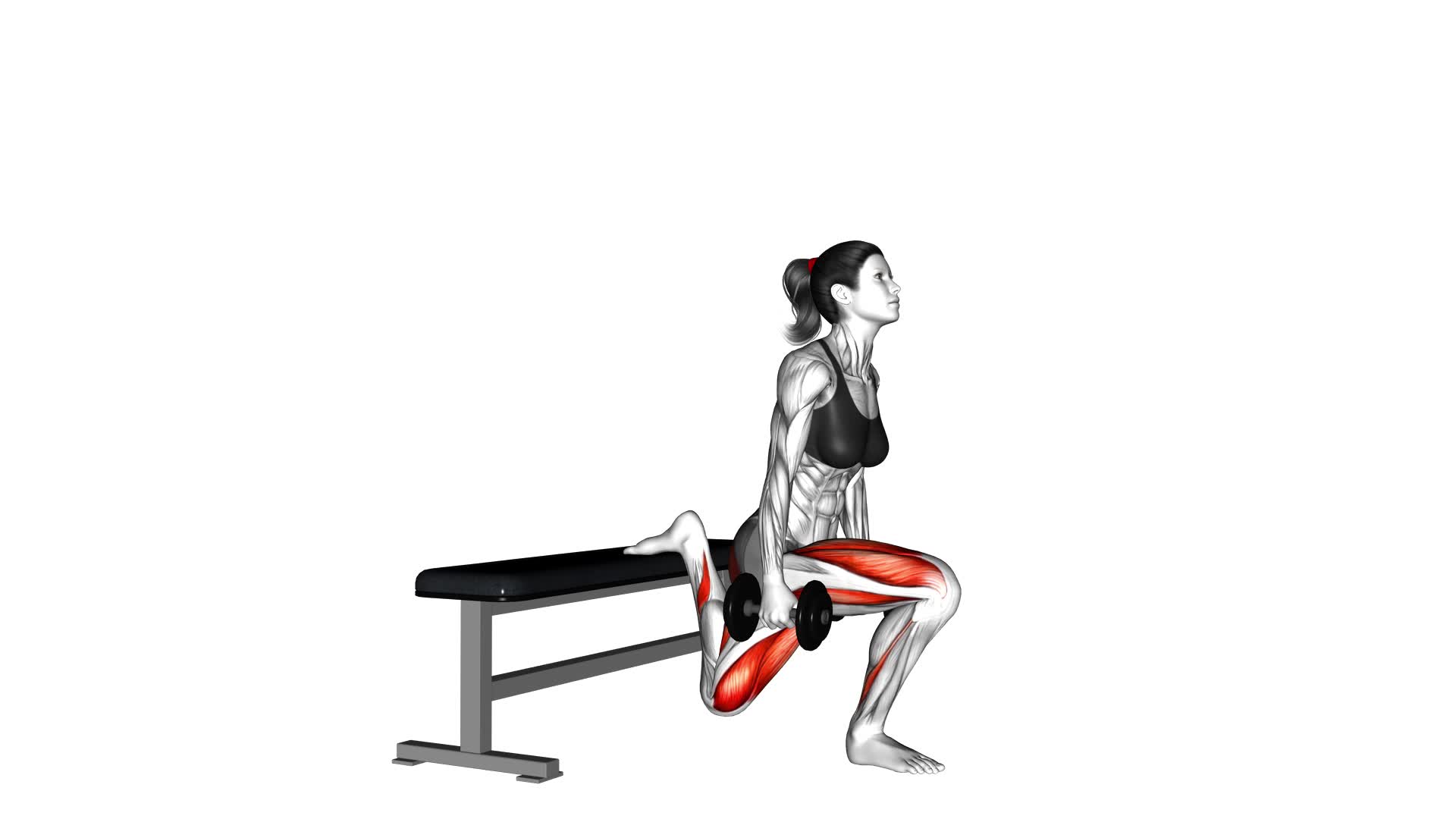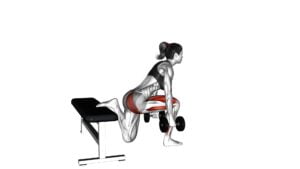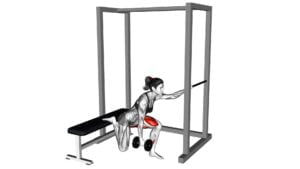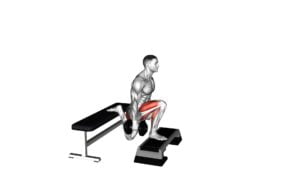Dumbbell Bulgarian Split Squat (female) – Video Exercise Guide & Tips

Looking to tone your legs and strengthen your glutes? The Dumbbell Bulgarian Split Squat is the perfect exercise for you.
Watch This Exercise Video
In this video exercise guide, we'll show you how to properly perform this exercise and provide tips to help you get the most out of your workout.
Whether you're a beginner or more advanced, there are variations and modifications to suit your fitness level.
Get ready to feel the burn and incorporate this effective exercise into your routine.
Key Takeaways
- Targets glutes, quadriceps, and hamstrings
- Improves lower body strength and power
- Enhances balance and stability
- Offers variations for different fitness levels
Benefits of the Dumbbell Bulgarian Split Squat
What are the benefits of performing the Dumbbell Bulgarian Split Squat?
The Dumbbell Bulgarian Split Squat is an excellent exercise that offers numerous benefits for your lower body strength and stability. One of the key benefits is the targeted activation of your glutes, quadriceps, and hamstrings. By performing this exercise, you can strengthen and tone these muscle groups, which can improve your overall lower body strength and power.
Additionally, the Dumbbell Bulgarian Split Squat also helps to improve balance and stability. Since you're balancing on one leg while performing the exercise, it requires core engagement and proprioception to maintain proper form. This can enhance your overall stability and coordination, which can be beneficial in various daily activities and sports.
Furthermore, the Dumbbell Bulgarian Split Squat offers variations that can be tailored to individual fitness levels and goals. You can increase the difficulty by using heavier dumbbells or incorporating plyometric movements, such as jump squats. On the other hand, if you're a beginner or have any limitations, you can start with bodyweight squats or use lighter dumbbells.
Proper Form and Technique for the Exercise
To perform the Dumbbell Bulgarian Split Squat with proper form and technique, start by standing with your feet hip-width apart and holding a dumbbell in each hand. Step your right foot back and place the top of your foot on a bench or elevated surface behind you. Keep your chest up and shoulders back as you lower your body down into a lunge position, making sure your front knee doesn't go past your toes. Push through your front heel to stand back up to the starting position. Repeat on the other side.
When performing this exercise, there are a few common mistakes to avoid. Firstly, avoid leaning too far forward or rounding your back. This can put unnecessary strain on your lower back and decrease the effectiveness of the exercise. Additionally, make sure to maintain control throughout the movement and avoid using momentum to push yourself up. Lastly, keep your core engaged throughout the exercise to stabilize your body and maintain proper form.
To incorporate the dumbbell Bulgarian split squat into your workout routine, start by performing 2-3 sets of 8-12 repetitions on each leg. You can use this exercise as a standalone leg exercise or as part of a lower body workout. It's important to start with a weight that challenges you but allows you to maintain proper form.
In the next section, we'll discuss how to choose the right dumbbell weight for the dumbbell Bulgarian split squat.
How to Choose the Right Dumbbell Weight
When choosing the right dumbbell weight for your Bulgarian split squats, there are a few key points to consider.
First, take into account your experience level and goals. If you're a beginner, start with a lighter weight and gradually increase as you become more comfortable and stronger.
Second, proper form and technique are crucial, so choose a weight that allows you to maintain good form throughout the exercise.
Lastly, aim for gradual weight progression to challenge yourself without sacrificing form or risking injury.
Experience Level and Goals
To choose the appropriate dumbbell weight for your experience level and goals, consider your strength and fitness level.
Your experience level plays a crucial role in determining the weight you should use for the dumbbell Bulgarian split squat exercise. If you're a beginner or have limited experience with strength training, it's recommended to start with lighter weights to focus on proper form and technique.
As you gain more experience and your strength improves, you can gradually increase the weight to challenge yourself.
Additionally, your goals should also influence your choice of dumbbell weight. If your goal is to build strength and muscle, you may want to choose a heavier weight that allows you to perform 8-12 repetitions with proper form.
On the other hand, if your goal is to improve muscular endurance, using a lighter weight for higher repetitions would be more appropriate.
Remember to always listen to your body and adjust the weight accordingly to ensure a safe and effective workout.
Proper Form and Technique
Choose the right dumbbell weight for the dumbbell Bulgarian split squat exercise by assessing your strength and fitness level. Proper form and technique are crucial to getting the most out of this exercise and avoiding injury.
Here are three important factors to consider when selecting the appropriate dumbbell weight:
- Start with a weight that challenges you: The dumbbell should feel heavy enough to challenge your muscles, but not so heavy that you sacrifice proper form. Gradually increase the weight as you get stronger and more comfortable with the exercise.
- Maintain proper posture: Keep your back straight, chest up, and shoulders back throughout the movement. This will help engage your core and prevent any unnecessary strain on your lower back.
- Modify the exercise if needed: If you find it difficult to maintain balance or perform the exercise with proper form, you can modify it by using a lighter dumbbell or even just your body weight. As you build strength and stability, you can gradually increase the weight or progress to more challenging variations.
Gradual Weight Progression
To gradually increase your strength and challenge your muscles, you can progress to heavier dumbbells as you become more comfortable with the dumbbell Bulgarian split squat exercise.
Weight progression is an important aspect of any workout routine, as it allows you to continually push yourself and see improvements in your strength and muscle tone. When choosing the right dumbbell weight for this exercise, start with a weight that challenges you but still allows you to maintain proper form throughout the movement.
As you become stronger and more proficient, gradually increase the weight in small increments. This gradual progression will help you avoid injury and ensure that you're continually challenging your muscles.
Now that you understand how to progress with weights, let's explore variations and modifications for different fitness levels.
Variations and Modifications for Different Fitness Levels
Now let's talk about the different variations and modifications you can make to the dumbbell Bulgarian split squat based on your fitness level.
If you're a beginner, there are modifications you can do to make the exercise easier and more manageable.
On the other hand, if you're more advanced, there are variations you can try to make the exercise more challenging and intense.
Beginner Modifications
Start with easier variations and modifications to accommodate different fitness levels. Here are three beginner modifications for the Dumbbell Bulgarian Split Squat:
- Bodyweight Split Squat: If you're new to this exercise, start by performing the split squat without any weights. This will help you focus on your form and build stability and strength in your legs.
- Elevated Heel: If you struggle with balance or have limited ankle mobility, try placing a small weight plate or a book under your front heel. This elevation can help you maintain proper form and reduce strain on your joints.
- Decrease Range of Motion: If you find it challenging to go all the way down in the split squat, you can decrease the depth of the movement. Start with a smaller range of motion and gradually increase it as you gain strength and flexibility.
Advanced Level Variations
Once you have mastered the beginner modifications, you can challenge yourself with advanced level variations of the Dumbbell Bulgarian Split Squat. These advanced modifications are designed to take your workout to the next level and push your limits.
One advanced modification is to increase the weight of the dumbbells you're using. This will add more resistance and intensity to the exercise, making it more challenging and effective.
Another advanced training technique is to incorporate plyometric movements into the exercise. This involves explosive movements such as jumping or switching legs in mid-air.
These advanced modifications and training techniques won't only test your strength and stability but also help you achieve greater results in your fitness journey.
Now, let's move on to discussing common mistakes to avoid while performing the exercise.
Common Mistakes to Avoid While Performing the Exercise
To avoid common mistakes while performing the Dumbbell Bulgarian Split Squat, make sure to maintain proper form throughout the exercise. This won't only help you prevent injuries but also ensure that you reap the full benefits of the exercise.
Here are three common mistakes to avoid:
- Incorrect positioning: One common mistake isn't positioning your feet properly. Make sure your front foot is far enough forward so that your knee doesn't extend past your toes when you lower your body. Your back foot should be elevated on a bench or step, with your toes pointing downward.
- Lack of stability: Another mistake isn't maintaining stability throughout the movement. Keep your core engaged and your torso upright throughout the exercise. Avoid leaning forward or allowing your back knee to collapse inward. This will help you target the correct muscles and maintain balance.
- Using improper weight: Using weights that are too heavy can lead to compromised form and increased risk of injury. Start with lighter weights and gradually increase as you become more comfortable with the exercise. Focus on maintaining proper form and stability rather than lifting heavy weights.
Tips for Incorporating the Dumbbell Bulgarian Split Squat Into Your Workout Routine
To effectively incorporate the Dumbbell Bulgarian Split Squat into your workout routine, it's essential to focus on proper form and gradually increase the intensity. When incorporating dumbbell squats into your workout, start by selecting an appropriate weight that challenges you but still allows you to maintain proper form throughout the exercise.
Begin by standing with your feet hip-width apart and take a step forward with one foot, placing the top of your back foot on a bench or step behind you. Lower your body down into a lunge position, making sure to keep your front knee directly above your ankle and your back knee hovering just above the ground. As you come back up, engage your glutes and quads to propel yourself back to the starting position. Repeat on the other leg.
Frequently Asked Questions
How Many Sets and Reps Should I Do for the Dumbbell Bulgarian Split Squat?
For the dumbbell Bulgarian split squat, the number of sets and reps you should do depends on your fitness level and goals. Generally, it's recommended to start with 2-3 sets of 8-12 reps for each leg.
This exercise helps to improve lower body strength, stability, and balance.
Variations of the Bulgarian split squat include using different weights, adding a jump or a plyometric element, or performing it on an unstable surface to further challenge your muscles.
Can I Do the Dumbbell Bulgarian Split Squat if I Have Knee or Hip Issues?
If you have knee or hip issues, you may need to modify the Dumbbell Bulgarian Split Squat or choose alternative exercises. It's important to prioritize your safety and avoid aggravating any existing conditions.
However, the Dumbbell Bulgarian Split Squat can be a great exercise for strengthening your lower body. It targets your glutes, quads, and hamstrings, helping to improve overall lower body strength.
Always consult with a qualified professional before attempting any new exercises.
Is It Better to Perform the Dumbbell Bulgarian Split Squat With a Bench or Without One?
To decide if it's better to do the dumbbell Bulgarian split squat with or without a bench, consider the variations and benefits.
Using a bench can provide stability and support, making it easier to maintain proper form. It also allows you to increase the range of motion and target different muscles.
However, doing the exercise without a bench can challenge your balance and engage your core more.
Ultimately, it depends on your goals and fitness level.
Can I Use a Kettlebell Instead of a Dumbbell for This Exercise?
Yes, you can use a kettlebell instead of a dumbbell for the dumbbell Bulgarian split squat. This exercise allows for alternative equipment options, and a kettlebell can provide a similar challenge and benefits as a dumbbell.
Just make sure to hold the kettlebell securely and maintain proper form throughout the exercise. It's always important to choose a weight that's appropriate for your fitness level and goals.
How Long Should I Rest Between Sets When Performing the Dumbbell Bulgarian Split Squat?
When performing the dumbbell Bulgarian split squat, it's important to consider the rest time between sets. Resting between sets allows your muscles to recover and prepares you for the next set.
The length of rest time can vary depending on your fitness level and goals. It's generally recommended to rest for 1-2 minutes between sets to ensure adequate recovery. However, feel free to adjust the rest time based on your personal preferences and how your body feels.
Conclusion
In conclusion, the Dumbbell Bulgarian Split Squat is a highly effective exercise for targeting the lower body muscles, improving balance and stability, and increasing overall strength.
By following proper form and technique, choosing the right dumbbell weight, and making necessary variations for different fitness levels, you can maximize the benefits of this exercise.
Avoid common mistakes and incorporate this exercise into your workout routine to achieve optimal results.

Author
Years ago, the spark of my life’s passion ignited in my mind the moment I stepped into the local gym for the first time. The inaugural bead of perspiration, the initial endeavor, the very first surge of endorphins, and a sense of pride that washed over me post-workout marked the beginning of my deep-seated interest in strength sports, fitness, and sports nutrition. This very curiosity blossomed rapidly into a profound fascination, propelling me to earn a Master’s degree in Physical Education from the Academy of Physical Education in Krakow, followed by a Sports Manager diploma from the Jagiellonian University. My journey of growth led me to gain more specialized qualifications, such as being a certified personal trainer with a focus on sports dietetics, a lifeguard, and an instructor for wellness and corrective gymnastics. Theoretical knowledge paired seamlessly with practical experience, reinforcing my belief that the transformation of individuals under my guidance was also a reflection of my personal growth. This belief holds true even today. Each day, I strive to push the boundaries and explore new realms. These realms gently elevate me to greater heights. The unique combination of passion for my field and the continuous quest for growth fuels my drive to break new ground.







